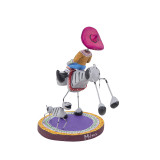Jinete - rider - standing ornament from Mexico - height 15 cm
- Original handicraft made of polychrome clay
- Unique object made in the spirit of Mexican popular art
- Only a few pieces on sale
- Intense colors, accurate hand-made decorations
- Dimensions: height 15 cm; width 11 cm
Funny figurines - Rider
People figurines are a very popular decorative element referring to the Mexican culture. The figurines can represent people in regional costumes used during national or religious holidays or Mexicans doing everyday activities. Faces of figurines are often depicted as skulls, so characteristic in Maya, Aztec or later Catrin culture. This form of representation of figurine faces is closely related to the beliefs and culture of Mexico, which indicates the inevitability of death its proximity and everydayness. Human figurines are a common decorative element adorning Mexican interiors, harmonizing with other ceramic elements decorating the space, such as tiles, jugs, or bowls.
Figurines in polychrome ceramics
This method of producing ceramics dates back to pre-colonial times and is often referred to as Mixtec ceramics due to its geographical location. After the Spanish took over Mexico in the 16th century, Mixtec ceramics were enriched with Spanish-Mauritian elements. Ceramics produced in Izúcar de Matamoros or as others say in La Puerta de la Mixteca are characterized by very high quality, attention to detail and deep color saturation. Decorative pieces in polychrome clay were most often ordered in reference to religious events. Mixtec ceramic products are most often made by artisans descended from the Castillo family, and the artisanal way of producing polychrome pottery makes it very popular with collectors around the world.
People figurines are a very popular decorative element referring to the Mexican culture. The figurines can represent people in regional costumes used during national or religious holidays or Mexicans doing everyday activities. Faces of figurines are often depicted as skulls, so characteristic in Maya, Aztec or later Catrin culture. This form of representation of figurine faces is closely related to the beliefs and culture of Mexico, which indicates the inevitability of death its proximity and everydayness. Human figurines are a common decorative element adorning Mexican interiors, harmonizing with other ceramic elements decorating the space, such as tiles, jugs, or bowls.
Figurines in polychrome ceramics
This method of producing ceramics dates back to pre-colonial times and is often referred to as Mixtec ceramics due to its geographical location. After the Spanish took over Mexico in the 16th century, Mixtec ceramics were enriched with Spanish-Mauritian elements. Ceramics produced in Izúcar de Matamoros or as others say in La Puerta de la Mixteca are characterized by very high quality, attention to detail and deep color saturation. Decorative pieces in polychrome clay were most often ordered in reference to religious events. Mixtec ceramic products are most often made by artisans descended from the Castillo family, and the artisanal way of producing polychrome pottery makes it very popular with collectors around the world.
Product Details
- Product code: BIZ-33
- Manufacturer: Cerames
- Colour Multicolor
- Material Ceramic
- Application Inside








